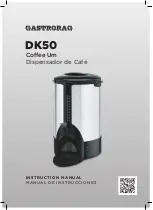
MHV 2 UL AF
10
Ugolini spa
flow charts”.
8. 1 INSTALLATION
1 - Loosen the fitting locker located on the rear cover of each
bowl equipped with Autofill Device and connect the remote
fill system using a 1/4” fitting suitable to the purpose.
Tighten the fitting locker.
2 - On the lower rear panel of the machine a 6-pole terminal
block is located. It is designed for connecting some acces-
sories such as a Safety Water Line Solenoid Valve and
one Sold-out Switch each bowl (see figure 17).
figure 17
3 - The Safety Water Line Solenoid Valve is intended to cut off
the main water line (if present in the remote fill system)
whenever the Autofill Device is not refilling.
The Sold-out Switch (one for each bowl) disables the Auto-
fill Device and activates acoustic and visual alarms whene-
ver the incoming beverage is sold out.
The Safety Water Line Solenoid Valve, if present, must be
connected to the unit using #1 and #2 poles of the termi-
nal block (see figure 17).
If a Safety Water Line Solenoid Valve is not used do not
use #1 and #2 poles.
If the remote fill system is equipped with Sold-out switches
connect their wires to #3 and #4 poles (for one bowl unit),
to #3, #4 and #5 poles (for two bowls unit) and to #3, #4,
#5 and #6 poles (for three bowls unit) as per figure 1 dia-
gram.
4 - The Autofill Device doesn’t come presanitized from the
factory. Prior to starting operation an In-Place Sanitization
is to be performed according with this handbook instruc-
tions (paragraph 3.3 IN-PLACE SANITIZATION).
8. 2 OPERATING PROCEDURES
Once the remote fill system is set up, follow the procedures
described in chapter 3.1 DESCRIPTION OF CONTROLS to
activate the Autofill system.
If the clip probe is properly installed and the bowl properly fitted
in their position, the remote fill system starts to operate and
feed the bowl through the hole in the rear wall. As soon as the
product level reaches the lowest tip of the probe, the priming
automatically stops.
As soon as the probe tip immersed in the product gets
uncovered (because of dispensed product), the solenoid valve
inside the rear wall automatically opens and fresh beverage
flows into the bowl until the probe tip gets covered again.
The solenoid valve opening occurs with about 10 seconds
delay to avoid that the irregular waving of product surface,
occasionally discovering probe tip, may be understood as level
dropping “cause of dispensing”.
A sold-out warning light along with a buzzer (visual and
acoustic sold-out alarms) are located respectively on and
inside the rear cover. They can run only if an applicable Sold-
out switch is connected to the terminal block (see figure 17).
8. 2. 1 DESCRIPTION OF CONTROLS
Each Autofill Device is equipped with a three position switch
located on the rear wall.
Its functions are as follows:
To operate the Autofill Device:
1 - Set the power switch of the unit to I position.
2 - If it is first time operation: manually energize the Autofill
Device, by keeping pushed the Autofill Switch in position II,
until the priming is completed. Set the Autofill swithch to I
position.
If this is not first time operation: set Autofill switch to I posi-
IMPORTANT
Whatever the remote fill system may be make sure that
the inlet product pressure into the Autofill Device is
not exceeding 2.5 bar (36 psi).
IMPORTANT
Safety Water Line Solenoid Valve must be 24V DC 12W
maximum.
IMPORTANT
If no Sold-out switch is used make sure that
#
3,
#
4,
#
5
and
#
6 poles on the terminal block are connected
together.
IMPORTANT
The device is designed so as no refilling occurs in
case either the clip probe is not properly installed or
the bowl not properly fitted.
I position
: Autofill Device is turned ON, provided that the
power switch of the unit is set to I.
0 position
: Autofill Device is turned OFF.
II position
: Autofill Device may be manually activated
(momentary position). By keeping manually
pushed the switch in this II position, it is
possible to manually activate the refilling by-
passing all the controls (both the clip probe
and the sold-out switches). This feature is
useful for priming in the first time operation or
whenever a sold-out occurs. The same
feature is also helpful for cleaning and
sanitizing procedures.


































